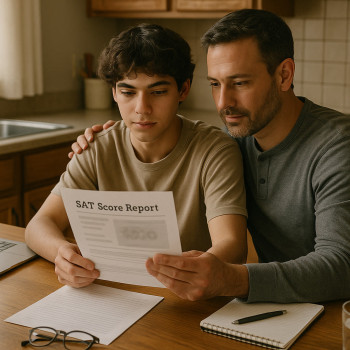Why this matters: SAT scores and Singapore university admissions — the short version
If you or your child are planning to apply from outside Singapore, or even from within Singapore to certain courses, the SAT can be a powerful credential. While Singapore’s universities evaluate applicants on multiple fronts — exam results, portfolios, interviews, and school records — an SAT score tells admissions officers something very specific and useful: how a student performs on a standardized college-readiness assessment that’s widely understood around the world.

This guide helps you understand where SAT results fit into the application process, how to decide whether to submit scores, the logistics of sending them from overseas, and how to combine SAT performance with other strengths to present a compelling application to Singapore’s universities.
Who uses SAT scores in Singapore — and why?
Different Singaporean institutions and programs treat SAT scores differently. Some undergraduate programs (especially those that receive many international applicants) accept or welcome SAT scores as an alternative or supplement to other qualifications. Reasons they value SAT scores include:
- Comparability: For international applicants, SATs provide a familiar benchmark that complements varied educational systems.
- Placement and advising: SAT subscores (Evidence-Based Reading & Writing and Math) can help with initial course placement and academic advising.
- Scholarships & awards: A strong SAT score can support scholarship applications or eligibility for certain awards.
That said, the role of the SAT isn’t uniform — some programs emphasize national exams, interviews, or subject-specific portfolios more. The key is research and tailoring: know the priorities of each program you apply to.
Deciding whether to take or send SAT scores
Ask three simple questions
- Does the program accept international qualifications and test scores? (Many do, but policies vary by faculty and major.)
- Will your SAT score strengthen an application that might otherwise be hard to compare against local qualifications?
- Could a strong SAT score help with scholarships, placement, or early offers?
If you answer yes to any of the above, the SAT is worth serious consideration. If you’re unsure, treat the SAT like insurance: a competitive score can only help, and you control which institutions receive it.
How Singapore universities typically view SAT scores in context
Admissions officers don’t see SAT scores alone. They consider them alongside:
- High school grades and transcripts
- National or regional exam results (if applicable)
- Personal statements and essays
- Recommendation letters
- Interview or audition performance
Think of your SAT as one clear data point in a multi-dimensional profile. For applicants from unfamiliar school systems, a strong SAT can make an application easier to interpret. For applicants from highly regarded systems, it can still provide useful evidence of readiness for specific types of coursework (e.g., quantitative majors).
Practical steps: When and how to send SAT scores to schools in Singapore
1. Timing matters
Plan your test date so your scores arrive before application deadlines. Score reporting typically takes a few weeks, and international deliveries or institutional processing can add time. If you want scores considered for scholarship rounds or early decisions, aim to have final scores well in advance of the earliest deadline.
2. Send scores officially from your College Board account
Universities expect official reports — that means scores sent directly from the test administrator. When you register or after you receive scores, use your account to designate recipient institutions. You can choose to send only a specific test date’s scores or all your scores (consider strategic choices when applying to schools that superscore or that require all scores).
3. Understand each university’s requirements
Some programs want all standardized test scores; others accept them optionally. Read the specific admissions pages for each faculty or program. If a university offers a choice between SAT, ACT, or other qualifications, choose the path that shows your strengths best.
Constructing a score strategy: target scores, superscoring, and more
Different strategies work depending on your profile and the program’s expectations. Here’s a short playbook.
Pick realistic target scores
- Research historical score ranges where available — competitive programs often list ranges or give guidelines.
- Set two targets: a ‘comfort’ score that reflects consistent practice performance, and an ‘aspirational’ score that you train toward with additional resources and tutoring.
Superscoring and whether it helps
Some institutions combine the best section scores from multiple test dates (this is called superscoring). If a Singapore university superscores, it can benefit candidates who are consistently strong in different sections across test dates. If they don’t, focus on a single strong test date.
When to retake the SAT
- Retake if your practice tests show clear improvements are likely from targeted study.
- Avoid repeating the test without a plan — use focused practice, review weak topics, and consider 1-on-1 guidance if you plateau.
Personalized tutoring — for example, Sparkl’s 1-on-1 guidance and tailored study plans — can be especially effective for breaking through plateaus by diagnosing exact content gaps and building efficient practice routines.
Putting SAT scores on the application — where and how to explain them
Application forms and personal statements
When you enter scores into application systems, follow instructions carefully: list the date, the section scores, and the total. Use optional essays or supplementary statements to explain strengths not captured by standardized tests — for instance, unusual circumstances, late blooming in a subject, or intensive projects that demonstrate readiness.
Use scores to support course fit
If you’re applying to a quantitatively rigorous major, spotlight your Math SAT if it’s strong. If your Reading & Writing score is a highlight, tie it to writing awards, literary projects, or research-related experiences. Admissions committees appreciate coherent narratives — don’t leave the SAT number floating by itself.
Comparing SAT with local qualifications in Singapore
Many local applicants will present national exam scores; international applicants often present a combination of national qualifications and standardized tests like the SAT. How admissions teams weigh these depends on the faculty and the applicant pool. A practical comparison:
| Measure | Strength | When it helps |
|---|---|---|
| SAT | Standardized, internationally comparable | International applicants, placement, scholarships |
| National exams (e.g., A-levels, IB) | Depth in coursework, subject mastery | Local equivalency, subject prerequisites |
| Portfolios/Interviews | Qualitative insight into creativity and fit | Art, design, performance, and programs emphasizing interviews |
Scholarships, financial aid, and how SATs can help
A high SAT can be an asset for scholarship committees, especially for awards that consider standardized metrics. Even when scholarships primarily focus on holistic achievements, test scores offer objective evidence that can open doors to merit-based opportunities.
If funding is a concern, check each university’s scholarship criteria and deadlines carefully. A well-timed, strong SAT submission could mean being considered for awards earlier in the admissions cycle.
Examples: Three different applicant stories
1) The international applicant seeking comparability
Rina studies in an educational system that doesn’t align neatly with Singaporean grade scales. Her strong SAT (especially Math) provides a directly comparable signal of academic readiness, increasing admissions officers’ confidence in placing her in competitive engineering programs.
2) The local student applying for an artistic major
Marcus has A-levels but also a high SAT Reading & Writing score. He uses his SAT as supplemental evidence of academic balance — showing that he’s both creative and academically prepared, which strengthens scholarship and honors program applications.
3) The student seeking scholarship boost
Amir didn’t have the highest school rank, but after raising his SAT total with a focused study plan and targeted tutoring, he gained eligibility for a merit scholarship that considered test scores alongside his leadership experience.
How to prepare efficiently: study plan, timing, and resources
Build a timeline
- 12–6 months before applications: diagnostic test, set target score, and create a weekly practice schedule.
- 6–3 months before: focus on weak areas, take full-length practice tests every 1–2 weeks, and simulate test-day conditions.
- 3–0 months before: fine-tune strategies, address time management, and finalize test date decisions.
Smart practice beats long hours
Quality matters: targeted practice on weak question types and timed sections will beat aimless studying. Use score reports to find patterns. If you consistently miss certain question types, build micro-sessions dedicated to those topics.
When to get help
If progress stalls after consistent effort, consider 1-on-1 tutoring to diagnose subtle skill gaps and establish accountability. Sparkl’s personalized tutoring — with tailored study plans, expert tutors, and AI-driven insights — can help many students convert small weaknesses into steady score gains without burning out.
Common pitfalls and how to avoid them
- Waiting too late to take the test: leaves no room for retakes if scores are below target.
- Sending scores without checking each program’s policy: some programs want all scores; some only want the best.
- Relying on raw scores without context: add essays and recommendation letters that explain your strengths and trajectory.
- Neglecting other parts of the application: stellar scores won’t replace weak grades or missing prerequisites.
Checklist: Final pre-application tasks
- Confirm each program’s test policy and deadlines.
- Decide which SAT test dates to send (single test vs. all scores).
- Request official score reports from the test administrator well before application deadlines.
- Use optional statements to connect SAT results to your academic narrative.
- Practice interview questions if the program uses interviews — SAT scores can be a conversation starter about preparation and fit.
Sample timeline and action table
| When | Action | Why it helps |
|---|---|---|
| 12 months before applications | Take a diagnostic SAT; set target scores | Gives baseline and timeline for improvement |
| 9–6 months before | Start targeted practice; consider 1-on-1 tutoring if needed | Build skills and strategy; time for retakes |
| 6–3 months before | Take a full official SAT test; review score report | Decide whether to retake or send |
| 3 months before applications | Send chosen scores; finalize essays and documents | Ensures scores are on file before deadlines |
| Application deadlines | Submit application and confirm receipt of scores | Reduce last-minute issues and confirm completeness |
Frequently asked questions
Do Singaporean universities prefer or require the SAT?
Not universally. Requirements vary by university and program. Many accept SATs, especially for international applicants, but always check the specific faculty’s admissions page for the most accurate guidance. If a school lists test submissions as optional, a strong SAT can still be advantageous.
How many times should I take the SAT?
There’s no single answer. Most students take it 1–3 times. The best plan is to prepare intentionally between attempts and to stop retaking once additional practice yields diminishing returns. Keep application deadlines in mind so scores arrive in time.
Will a low SAT hurt my application?
A lower-than-expected SAT doesn’t automatically disqualify you, but it may mean other parts of your application need to be stronger to compensate. Use essays, recommendations, and extracurricular evidence to create a fuller picture of your capabilities and potential.
Final thoughts: Make the SAT work for your story
The SAT is a versatile tool — especially for international applicants to Singapore’s universities. It provides a familiar, comparable measure of academic skills and can bolster scholarship applications, placement decisions, and admissions committees’ confidence in your readiness. But it’s not the whole story. The strongest applications weave scores into a clear narrative that highlights genuine interests, academic preparation, and personal growth.
If you or your student would benefit from individualized help, consider guided options that focus on the specific gaps in your prep. Personalized, 1-on-1 tutoring and adaptive study plans — like those offered by Sparkl — can help you raise scores efficiently while keeping time for everything else an application demands.

Start early, be strategic about which scores you send, and tell a coherent story across your application materials. With preparation that’s thoughtful and targeted, your SAT score can be a clear, helpful signal in the Singapore university admissions process.
Ready to take the next step?
Make a plan: take a diagnostic, choose target test dates, and map out application deadlines. Small, consistent steps—supported by focused practice or a tailored tutor—often produce the biggest gains. Good luck; you’ve got this.
















No Comments
Leave a comment Cancel